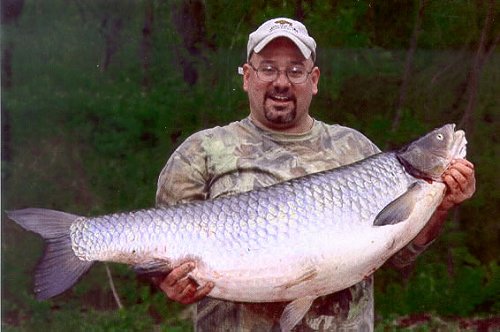Carp
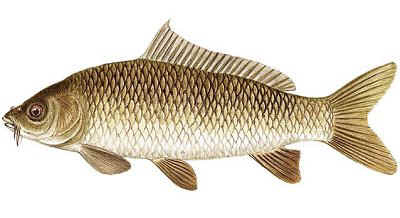
Cyprinus carpio
Size
to 36"
( record over 6 ft )
Description
A heavy-bodied, laterally compressed minnow with a long dorsal fin and arched back. The first ray of the dorsal and anal fins is a stout, serrated spine. The small triangular head tapers to a blunt snout. The small, protrusible mouth contains no teeth and is located below the snout. There are two pairs of barbels on the upper jaw. Body color is brassy green on top grading to bronze or gold on sides. The belly is yellowish-white. Fins typically are yellow, orange, golden, or light olive in color. The wild type of common carp is completely covered with large, round scales. Mirror carp has a few very large scales scattered over the body and leather carp are virtually scaleless.

Carp is widely distributed in North America. Common carp are non-native fish from Europe which were first introduced to the United States in the late 1800s. Brilliantly colored Koi (right) were developed from ordinary carp several hundred years ago in Japan, and are widely used in ornamental ponds.
Habitat
The primary habitat types found in the main channel of the Apalachicola River are steep natural banks, gentle banks, dike fields, sand disposal areas, rock outcrops, and submerged vegetation. In the Ochlockonee River, the upper stretch of the main channel is narrow and shallow with steep banks and becomes progressively wider and deeper with lower banks downstream. There are numerous sand bars, point bars, sand shoals, and backwater sloughs.
Spawning Habits
Carp spawn when water temperatures range between 65 and 75 F. Small groups gather in shallow, heavily vegetated areas that warm rapidly. One or more males pursue a female as eggs and milt are released. The eggs sink and adhere to vegetation and debris on the bottom. No parental care is given to the eggs. Egg production depends on the size of the female with anywhere from 50,000 to 2 million eggs spawned by a single female.
Feeding Habits
Most often carp suck up quantities of silt, spit it out, and select out insect larvae, crustaceans, snails, and other food items. Young carp will also consume zooplankton. Adult carp are omnivorous, consuming both plant and animal foods. Plant foods include both rooted plants and algae. Organic debris can also be an important component of the diet.
Age and Growth
Few wild carp live longer than 12 years but individuals in captivity have lived as long as 47 years. Carp generally grow rapidly for the first few years until they reach sexual maturity and slows as energy is diverted into reproduction. Growth rates of carp vary considerably across North America which may reflect geographical, biological, and environmental conditions at different locations.
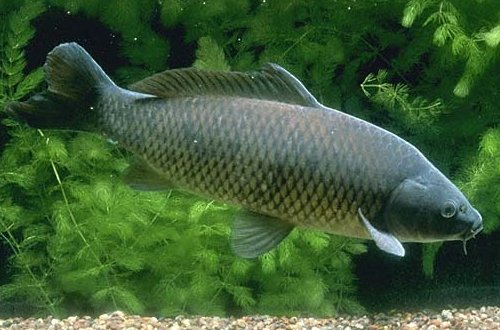
Common Carp: Several hundred years of selective breeding turns this ...
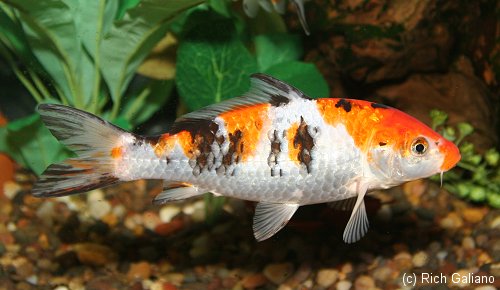
... into this - Japanese Koi. Goldfish have undergone several thousand years of breeding in China to develop some truly bizarre and even grotesque morphs.
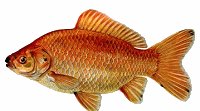
Goldfish ( Carassius auratus ) are closely related to Carp, but lack barbels at the corners of the mouth. They may grow up to 18", but lose their bright colors after a few generations in the wild. Goldfish are the product of thousands of years of selective breeding in China. Many varieties are so exotically mutated that they would be utterly unable to survive outside of captivity.
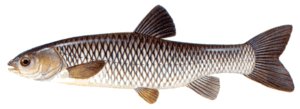
Grass Carp ( Ctenopharyngoden idella ) is another Asiatic species that has been widely introduced for control of aquatic vegetation. This fish can eat more than its weight in water weeds every day, and quickly grows to 4 feet and over 50 pounds. Generally, only sterile specimens are stocked, otherwise, large numbers of these big voracious fishes would do more destruction than good.
